UPSC Daily Current Affairs: 18th October 2024 | Current Affairs & Hindu Analysis: Daily, Weekly & Monthly PDF Download
GS3/Defence & Security
INS Samarthak
Source: Times of India
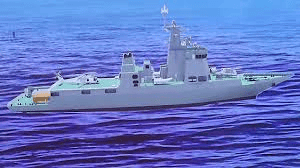
Why in news?
Larsen and Toubro (L&T) has recently unveiled the INS 'Samarthak', a versatile vessel specifically designed for the Indian Navy.
Overview of INS Samarthak:
- The INS Samarthak is the first of two planned multi-purpose vessels (MPVs).
- This vessel has been entirely designed and built in-house by L&T at their shipyard located in Kattupalli.
- The project aligns with the Indian government's initiatives, including 'Make in India' and the 'Atmanirbhar Vision', promoting self-reliance in defense production.
- INS Samarthak serves as a specialized platform capable of multiple roles, including:
- Development and testing of advanced weapons and sensors.
- Maritime surveillance operations.
- Patrolling coastal and maritime areas.
- Launching and retrieving both surface and aerial targets.
- Providing humanitarian assistance during emergencies.
- Combatting marine pollution through various measures.
Technical Specifications:
- The vessel has an impressive length of 107 meters and a width of 18.6 meters.
- It boasts a displacement exceeding 3,750 tonnes.
- INS Samarthak can reach a maximum speed of 15 knots, enabling efficient operations.
Significant Features of L&T's Kattupalli Shipyard:
- Kattupalli Shipyard is located approximately 45 km north of Chennai, Tamil Nadu.
- This facility is recognized as one of India's most advanced shipbuilding and repair yards.
- It is equipped with state-of-the-art facilities, including shiplifts, dry berths, and wet berths to facilitate concurrent construction and repair operations.
- In addition to the two MPVs, the shipyard is also engaged in building:
- Three Cadet Training Ships.
- Six additional defense vessels for the Indian Navy under a Public-Private Partnership model.
- The yard is also involved in the repair of the US Naval Ship Charles Drew under a Master Ship Repair Agreement with the US Navy.
GS3/Economy
Centre claims fortified rice is safe for consumption for everyone
Source: The Hindu

Why in news?
The Centre defended its initiative to supply fortified rice, aimed at combating micronutrient deficiencies, amid safety concerns and claims that it benefits multinational companies. The Union Food Ministry emphasized that iron-fortified rice is safe, following World Health Organization (WHO) guidelines, and is globally recognized.
About/definition
The Food Safety and Standards Authority of India (FSSAI) defines fortification as the intentional addition of essential micronutrients to food to enhance its nutritional quality and provide public health benefits, while posing minimal health risks.
Need for fortification of rice
- Malnutrition in India, especially among women and children
- According to the National Family Health Survey (NFHS-5), anaemia affects a significant portion of the population, with every second woman being anaemic and every third child stunted.
- Deficiencies in iron, Vitamin B12, and folic acid are widespread, impacting health and productivity.
Fortification of Rice as a Solution
- Rice, a staple food for two-thirds of India’s population, is an ideal candidate for fortification to combat malnutrition.
- Per capita rice consumption in India stands at 6.8 kg per month; fortifying it with micronutrients can help enhance the diet of underprivileged communities.
Fortification Process
- Fortification technologies include coating, dusting, and extrusion, with extrusion being the most suitable method for India.
- In the extrusion process, dry rice flour is mixed with micronutrients and water, then passed through an extruder to create fortified rice kernels (FRKs) that resemble regular rice.
- These kernels are blended with regular rice in a ratio of 10g FRK to 1 kg of rice to produce fortified rice.
Nutrient Content in Fortified Rice
According to FSSAI standards, 1 kg of fortified rice contains:
Nutrient | Content per kg |
|---|---|
| Iron | 28 mg - 42.5 mg |
| Folic acid | 75 - 125 micrograms |
| Vitamin B12 | 0.75 - 1.25 micrograms |
It may also be fortified with additional micronutrients like zinc, vitamin A, and various B vitamins.
Cooking and Consumption of Fortified Rice
- Fortified rice is prepared and consumed just like regular rice, and it retains its micronutrient levels even after cooking.
- Packaging is marked with a logo (‘+F’) and labeled as “Fortified with Iron, Folic Acid, and Vitamin B12.”
Progress of the Rice Fortification Initiative
- In 2015, PM Modi announced that rice distributed under government schemes, such as the Public Distribution System (PDS) and Mid-Day Meal Scheme, would undergo fortification by 2024.
- The Centre implemented this initiative in phases:
- Phase 1: Integrated Child Development Services and PM POSHAN by March 2022.
- Phase 2: PDS and welfare schemes in 112 Aspirational Districts by March 2023.
- Phase 3: Full nationwide coverage by March 2024.
Rice fortification ecosystem in India
- Manufacturers and Premix Suppliers
- India boasts 1,023 rice kernel manufacturers producing 111 LMT of fortified rice annually, which is significantly more than the 5.20 LMT required for the program.
- Additionally, 232 premix suppliers produce 75 LMT annually, far exceeding the 0.104 LMT needed.
Expansion of Fortification Infrastructure
- The rice fortification ecosystem has expanded considerably, with over 21,000 out of 30,000 operational rice mills now equipped with blending equipment.
- This enables a monthly production capacity of 223 LMT of fortified rice.
Distribution of fortified rice
- The distribution is conducted under schemes such as Pradhan Mantri Garib Kalyan Anna Yojana (PMGKAY), Integrated Child Development Service (ICDS), and PM POSHAN (formerly MDM).
- Recently, in October 2024, the government approved the continuation of the universal supply of fortified rice under all Union government schemes, including PMGKAY, from July 2024 until December 2028.
About the news:
In a statement, the Union Food Ministry asserted that scientific evidence indicates that iron-fortified rice is safe for everyone. It emphasized that India adheres to WHO guidelines and that fortification is an internationally recognized practice.
Health Advisory for Fortified Rice Packaging
The Food Ministry stated that, under the Food Safety and Standards (Fortification of Foods) Regulations, 2018, fortified rice packaging was initially required to include a health advisory for individuals with Thalassemia and Sickle Cell Anaemia. However, a scientific committee questioned the necessity of this advisory, noting that no other country mandates such labeling.
Safety Assessment for Individuals with Hemoglobinopathies
A working group from the Ministry evaluated the safety of iron-fortified rice for people with hemoglobinopathies, which are inherited disorders affecting hemoglobin structure or production in red blood cells. These conditions can lead to issues such as sickle cell anemia and thalassemia, causing abnormal oxygen transport and various health complications. They concluded that current scientific evidence does not suggest any safety concerns for such individuals consuming fortified rice.
Iron Intake in Thalassemia Patients
The Ministry clarified that the iron intake from fortified rice is minimal compared to the iron absorbed through blood transfusions in Thalassemia patients. Additionally, fortified rice undergoes chelation to manage any potential iron overload.
Iron Absorption in Sickle Cell Anaemia Patients
Individuals with Sickle Cell Anaemia are unlikely to absorb excess iron from fortified rice due to naturally higher levels of hepcidin, a hormone that regulates iron absorption, which reduces the risk of iron overload in these patients.
GS3/Science and Technology
West Nile Virus
Source: The Hindu
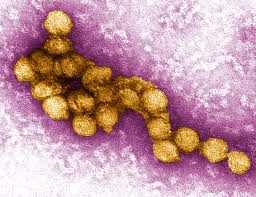
Why in news?
Ukraine is currently facing a significant outbreak of West Nile virus (WNV), prompting health officials to issue warnings as the number of fatalities increases.
About West Nile Virus
- Virus Type: Belongs to the flavivirus genus within the family Flaviviridae.
- First Isolated: Identified in 1937 from a woman in the West Nile district of Uganda.
- Geographical Distribution: Frequently found across Africa, Europe, the Middle East, North America, and parts of West Asia.
- Transmission:
- Primarily spread via bites from infected mosquitoes, which acquire the virus by feeding on infected birds.
- Can also be transmitted through infected animal tissues.
- Symptoms:
- Asymptomatic: Approximately 80% of those infected do not exhibit symptoms.
- West Nile Fever: About 20% develop symptoms such as fever, headache, fatigue, body aches, nausea, vomiting, and sometimes skin rashes.
- Peak Infection Period: Typically occurs from June to September, marking the transition from summer to autumn.
- Reported Outbreaks: Outbreaks have been documented in 19 countries, including Albania, Austria, Bulgaria, Croatia, Cyprus, Czechia, France, Germany, Greece, Hungary, Italy, North Macedonia, Romania, Serbia, Slovakia, Slovenia, Spain, Türkiye, and Kosovo.
- Treatment: No vaccine is currently available; treatment primarily involves supportive care for patients with neuroinvasive WNV.
GS2/Governance
What is the Employees Deposit Linked Insurance (EDLI) Scheme?
Source: Business Standard

Why in News?
The Centre has decided to extend providing benefits of Employees’ Deposit Linked Insurance (EDLI) Scheme to all subscribers of Employees’ Provident Fund Organisation and their family members till further notice.
About Employees Deposit Linked Insurance (EDLI) Scheme:
- EDLI is an insurance initiative launched by the Government in 1976.
- The primary goal of the scheme is to offer social security benefits to private sector employees, particularly where such benefits may not be commonly provided by employers.
- The scheme is managed by the Employees Provident Fund Organisation (EPFO) and provides term life insurance coverage for member employees.
- EDLI encompasses all organizations registered under the Employees Provident Fund (EPF) and Miscellaneous Provisions Act of 1952.
- This scheme operates in conjunction with the EPF and the Employees' Pension Scheme (EPS).
- The benefits under the EDLI scheme are determined based on the last drawn salary of the employee.
- In the event of the death of an EPF member during their service period, the registered nominee receives a lump-sum payment.
- The coverage provided by the EDLI scheme is similar to that of the EPF Scheme.
Features
- The maximum assured benefit under the scheme can go up to Rs 7 lakh, payable to the nominee or legal heir of the EPF member if death occurs while they are in service.
- If the deceased member had continuous employment for at least 12 months before their death, a minimum assurance benefit of Rs 2.5 lakh is provided.
- The life insurance benefit available to EPFO members comes at no cost to the PF/EPF account holders.
- Employers contribute minimally at a rate of 0.5% of the employee's monthly wages, capped at a wage ceiling of Rs 15,000; employees do not make any contributions.
- PF members are automatically enrolled in the EDLI scheme upon registration.
- The benefits are directly credited to the bank account of the legal heir or nominee.
GS3/Environment
African Penguin
Source: DTE
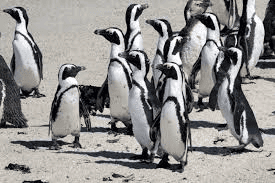
Why in News?
A recent research study conducted by a collaborative team from South Africa and the United Kingdom has revealed that the use of artificial nests can significantly improve the breeding success rates of African penguins.
About African Penguin:
- Appearance: The African penguin is characterized by a distinctive black stripe and unique black spots on its chest. Additionally, it possesses pink glands located above its eyes, which intensify in color as the penguin's body temperature rises. Males are generally larger than females, featuring bigger beaks.
- Habitat: This species is typically found within a 40-kilometer radius of the coastline, where it comes ashore to engage in breeding, molting, and resting activities.
- Distribution: African penguins breed along the African mainland from Hollams Bird Island in Namibia to Bird Island in Algoa Bay, South Africa. They naturally establish nests in burrows created in guano, a substance made up of the droppings of birds, bats, and seals, which provides essential protection from the harsh heat of their habitat.
- Lifespan: In the wild, African penguins typically live for about 20 years.
- Diet: Their diet mainly consists of pelagic schooling fish, with a particular preference for sardines and anchovies.
Conservation status
- IUCN Status: The African penguin is classified as endangered.
- Threats: The primary threats to this species stem from changes induced by global warming, which adversely affect both the marine and atmospheric environments where these penguins reside, posing significant risks to their habitats.
GS2/International Relations
Hand-in-Hand Initiative
Source: Food and Agriculture Organisation
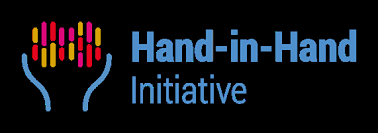
Why in news?
Recently, the Director-General of the Food and Agricultural Organisation (FAO) inaugurated the third Hand-in-Hand Investment Forum.
About Hand-in-Hand Initiative:
- The Hand-in-Hand Initiative was launched in 2019 as a flagship program of the FAO.
- This initiative focuses on countries and regions experiencing the highest levels of poverty and hunger, where national capacities are limited, or where operational challenges arise from natural or human-made crises.
- The objective is to eradicate poverty (SDG1), eliminate hunger and malnutrition (SDG2), and reduce inequalities (SDG10) by fostering a market-oriented transformation of agri-food systems.
- It aims to enhance income, improve nutrition, empower vulnerable populations, and bolster resilience against climate change.
Approach:
- The initiative employs geospatial, biophysical, and socio-economic data, along with advanced analytics to pinpoint regions where agricultural transformation and sustainable management of forests and fisheries can effectively combat poverty and hunger.
- Interventions include developing value chains for key commodities, establishing agro-industries, implementing efficient water management systems, and promoting digital services and precision agriculture.
Member countries:
- A total of 72 countries have signed up for this initiative.
What is FAO?
- FAO is a specialized agency of the United Nations (UN) dedicated to international efforts aimed at ending hunger.
- It is the oldest permanent specialized agency of the UN, having been established in October 1945.
- The mandate of FAO includes improving nutrition, enhancing agricultural productivity, raising living standards in rural areas, and contributing to global economic growth.
- FAO currently comprises 194 Member States along with the European Union as a member organization.
- The headquarters of FAO is located in Rome, Italy.
GS3/Economy
SARTHI System
Source: Business Today
Why in news?
Recently, the National Institute of Food Technology Entrepreneurship and Management, Kundli (NIFTEM-K) has launched the Solar Assisted Reefer Transportation with Hybrid Controls and Intelligence (SARTHI) system.
About SARTHI System:
- The SARTHI system is a groundbreaking solution aimed at decreasing post-harvest losses in the transportation of perishable foods.
Features:
- The system includes dual compartments specifically designed to maintain different temperature settings for fruits and vegetables, accommodating their distinct storage requirements.
- It integrates Internet of Things (IoT) technology along with real-time monitoring capabilities.
- Data from sensors is collected and transmitted to the cloud, where it can be accessed via a mobile application, providing real-time insights into quality parameters and physiological changes occurring during the transport of fresh produce.
- The sensors involved monitor critical factors such as temperature, humidity, ethylene, and CO2 levels, sending this data directly to a mobile app to facilitate quality assessment.
- Additionally, the system is equipped with a solar-powered air handling unit that maintains temperature control during stops in transit.
Significance:
- This innovative design not only helps to prolong the shelf life of perishable goods but also mitigates losses due to chilling injury or moisture loss.
- The technology empowers transporters to make data-driven decisions; for instance, if spoilage is detected, they can reroute the produce to closer markets. This capability helps reduce energy waste and lower carbon footprints.
GS3/Science and Technology
Drugs Technical Advisory Board (DTAB)
Source: The Hindu

Why in news?
The Drugs Technical Advisory Board (DTAB), which is the highest statutory body overseeing technical drug-related matters in India, has recommended that all antibiotics be classified under the definition of 'New Drugs' as per the New Drugs and Clinical Trial (NDCT) Rules, 2019.
Definition of New Drugs
- A new drug is defined under Rule 122 E of the Drugs and Cosmetics Rules, 1945, as a drug that:
- Has not previously been used in India.
- Has not been recognized as safe and effective by the licensing authority.
- May be an already approved drug but with altered claims, such as new indications, dosages, or routes of administration.
Implications of Classifying Antibiotics as New Drugs
- Manufacturing, marketing, and sale of antibiotics will be more thoroughly documented.
- Clearance for manufacturing and marketing will be required from the Central Government instead of State drug administrations.
- Antibiotics will be available to patients only with a prescription.
Additional Recommendations
- The board is considering amendments to the labeling rules of the Drugs Rules, 1945, proposing a blue strip or box for antimicrobial products.
- It has suggested that non-pharmaceutical industries should not handle antimicrobials unless they possess the required licenses.
About the Drugs Technical Advisory Board
- Authority: It serves as the highest statutory decision-making body on technical drug matters in India.
- Establishment: Formed under the Drugs and Cosmetics Act, 1940.
- Affiliation: Part of the Central Drugs Standard Control Organization (CDSCO).
- Nodal Ministry: Operates under the Ministry of Health and Family Welfare.
- Functions:
- Advises both Central and State Governments on technical issues related to the Drugs and Cosmetics Act.
- Performs functions assigned by the Act.
Role of CDSCO:
- Approval of drugs.
- Oversight of clinical trials.
- Establishment of drug standards.
- Quality control for imported drugs.
- Coordination with State Drug Control Organizations.
- Specialized Licenses: Responsible for granting licenses for critical categories of drugs, including blood products, IV fluids, vaccines, and sera.
- Decision-Making: Offers expert advice and technical recommendations to ensure the safety, efficacy, and quality of drugs.
GS3/Environment
Climate change impact harsher on poorer farmers in India: FAO report
Source: The Hindu

Why in news?
On October 16, 2024, the Food and Agriculture Organization (FAO) reported that low-income households across the globe experience a significant financial loss each year due to climate-related stressors, suffering an average of 5% income loss from heat stress and 4.4% from floods.
- The FAO, established on October 16, 1945, is a specialized agency of the United Nations (UN) dedicated to combating hunger and advancing food security and nutrition on a global scale. Its headquarters are located in Rome, Italy, and it includes 195 members, comprising 194 countries and the European Union.
Key Objectives of the Food and Agriculture Organization (FAO):
- Eradicate Hunger and Malnutrition: The FAO's mission is to eliminate hunger, food insecurity, and malnutrition by promoting sustainable agricultural practices and enhancing food availability.
- Promote Sustainable Agriculture: The organization advocates for sustainable management of natural resources and resilient agricultural systems to address climate change and safeguard biodiversity.
- Reduce Rural Poverty: FAO strives to enhance the livelihoods of rural communities through economic development, social protection initiatives, and better market access.
- Enhance Food Systems: The focus is on improving the production, distribution, and consumption of food to ensure that the global population has access to nutritious, safe, and affordable food.
- Respond to Crises: FAO aids countries in managing food-related emergencies and building resilience against future challenges, including natural disasters and conflicts.
Key Highlights of the Present Report by FAO:
- Economic Losses from Climate Stress: The report emphasizes that poorer households globally lose an average of 5% of their income annually due to heat stress and 4.4% from floods, in contrast to their wealthier counterparts.
- Impact on Rural Poor in India: The report indicates that rural poor households in India face unique challenges due to climate stress, such as diminished off-farm employment opportunities during droughts, compelling them to invest more resources in agriculture.
- Structural Inequalities: It is noted that the vulnerability of poorer households to climate stressors stems from systemic inequalities, highlighting the need for policy interventions like expanding social security measures.
- Recommendations for Livelihood Support: The FAO recommends scaling up anticipatory social protection programs and enhancing off-farm employment opportunities to minimize dependence on detrimental coping strategies.
- Gender and Employment Barriers: The report calls for addressing gender imbalances in non-farm employment through transformative approaches to combat discriminatory norms.
What is NITI Aayog’s Response?
- Efforts to Combat Climate Change: NITI Aayog has noted India's proactive initiatives, such as the National Innovations on Climate Resilient Agriculture (NICRA) project, which aids farmers in adapting to severe climatic conditions.
- Social Safety Nets: It emphasizes the implementation of a nationwide employment guarantee scheme and extensive food distribution efforts during the pandemic as part of social protection strategies.
- Women’s Workforce Participation: Citing data from the Periodic Labour Force Surveys, NITI Aayog highlights an increase in female workforce participation, indicating progress in addressing gender-related issues.
- Open to FAO Suggestions: The organization acknowledges the importance of considering the FAO’s recommendations for further policy enhancement while emphasizing the value of India’s current initiatives.
Way forward:
- Strengthen Social Protection: There is a need to expand anticipatory social protection programs and implement climate-resilient agricultural practices to support vulnerable households and reduce income losses from climate stress.
- Address Structural Inequalities: Efforts should be made to improve off-farm employment opportunities, address gender disparities, and apply policies that target the fundamental causes of vulnerability to climate-related risks.
GS3/Environment
World Energy Outlook 2024
Source: Hindustan Times
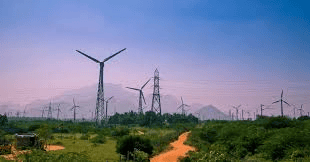
Why in News?
India is poised to face a higher increase in energy demand than any other country over the next decade, according to the World Energy Outlook 2024.
About World Energy Outlook 2024:
- It is an annual report published by the International Energy Agency (IEA).
- It serves as the most authoritative global source for energy analysis and projections.
- The report identifies and examines the most significant trends in energy demand and supply.
- It also assesses implications for energy security, emissions, and economic development.
Highlights of 2024 Report:
- Projections suggest that the world is entering a new energy landscape, characterized by persistent geopolitical risks alongside an abundance of various fuels and technologies.
- A surplus of oil and liquefied natural gas (LNG) is anticipated in the latter half of the 2020s.
- There is expected to be a considerable increase in manufacturing capacity for critical clean energy technologies.
- Low-emission energy sources are projected to account for more than half of the world's electricity generation by 2030.
- Demand for coal, oil, and gas is expected to peak by the end of this decade.
- Global electricity demand growth is forecasted to accelerate, adding an amount equivalent to Japan's annual electricity usage each year.
Highlights Related to India:
- India's energy demand is set to rise significantly due to its size and growing needs across all sectors.
- According to the Stated Policies Scenario (STEPS), India is on course to add over 12,000 vehicles to its roads daily until 2035.
- Annual built-up space is projected to increase by over 1 billion square meters, surpassing the total built space in South Africa.
- By 2035, iron and steel production is expected to grow by 70%.
- Cement production is anticipated to rise by nearly 55%.
- The stock of air conditioners is projected to increase by over 4.5 times, leading to electricity demand from air conditioners in 2035 exceeding Mexico’s total expected consumption that year.
- Total energy demand in India is projected to rise by approximately 35% by 2035.
- Electricity generation capacity is expected to nearly triple to 1400 GW.
- Coal is expected to maintain a significant role in India’s energy mix over the coming decades, with the addition of around 60 gigawatts of new coal-fired power capacity by 2030.
- Coal-based electricity generation is projected to increase by over 15%.
- In 2023, coal accounted for 40% of the energy utilized in industries such as steel, cement, and manufacturing.
- By 2035, coal use in the industrial sector is expected to grow by 50%.
GS2/Polity
On the Exception to Marital Rape
Source: The Hindu
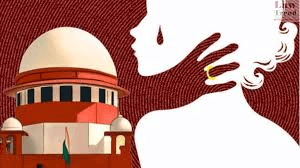
Why in news?
The topic of marital rape in India has recently gained attention due to ongoing legal and social debates surrounding its implications and the existing legal framework that currently exempts husbands from prosecution for non-consensual sexual acts with their wives. This exemption is being challenged on the grounds that it violates women's fundamental rights.
Background:
- The issue of marital rape in India is a prominent subject of legal and social discourse.
- According to Exception 2 of Section 375 of the Indian Penal Code (IPC), husbands cannot be prosecuted for non-consensual sexual acts with their wives, provided the wife is over 18 years of age.
- This legal exemption is being questioned as a violation of women's fundamental rights.
History & Genesis of Marital Rape Exception:
- The concept of marital rape exception is rooted in English common law, particularly the doctrine of coverture, which treated married couples as a single legal entity.
- This doctrine implied that a wife could not legally refuse her husband's sexual advances.
- British jurist Matthew Hale, in the 1700s, claimed that marriage constituted irrevocable consent to sexual relations, leading to the belief that a husband could not rape his wife.
- Although England abolished this exception in 1991, India continues to uphold it.
- In 2017, the Supreme Court of India increased the age of consent for marital intercourse from 15 to 18 years in the case of Independent Thought vs. Union of India.
- Despite this change, the marital rape exception remains in effect under Indian law.
Current Legal Framework:
- The IPC defines rape and outlines scenarios in which sexual intercourse is considered non-consensual.
- Exception 2 provides immunity for husbands from prosecution for non-consensual acts with their wives, as long as the wives are over 18.
- Other legal measures, such as Section 85 of the Bharatiya Nyaya Sanhita (BNS) and the Protection of Women from Domestic Violence Act (2005), offer some protection but mainly address issues of cruelty rather than sexual violence.
Arguments Against the Marital Rape Exception:
- Violation of Fundamental Rights:
- Article 14: The marital rape exception creates a disparity between married and unmarried women, with only unmarried women receiving full legal protection against sexual assault.
- Article 21: This exception infringes on a woman's right to bodily autonomy and privacy, as emphasized in Supreme Court rulings such as Puttaswamy vs. Union of India and Joseph Shine vs. Union of India.
- Gender Equality:
- Critics argue that the marital rape exception perpetuates patriarchal norms, suggesting that marriage grants husbands unqualified sexual access to their wives, thereby undermining women's rights.
- International Perspective:
- Numerous countries, including the UK, USA, and Australia, have abolished the marital rape exception.
- Maintaining this exception in India places it at odds with contemporary legal standards regarding women's rights and sexual autonomy.
Judicial Precedents:
- Karnataka High Court (2022): In Hrishikesh Sahoo vs. State of Karnataka, the court ruled that a husband could be prosecuted for raping his wife, marking a crucial shift in addressing sexual violence within marriage.
- Delhi High Court Split Verdict (2022): Justice Rajiv Shakdher deemed the marital rape exception unconstitutional, asserting it violates women's rights to bodily autonomy, while Justice C. Hari Shankar upheld it, claiming that sexual relations within marriage constitute a "legitimate expectation." This split decision led the petitioners to escalate the matter to the Supreme Court.
Government's Stand:
- Recently, the Union Government submitted an affidavit opposing the removal of the marital rape exception, arguing that marriage entails a "continuing expectation of reasonable sexual access."
- The government expressed concerns that criminalizing marital rape could undermine the sanctity of marriage and result in false allegations.
Conclusion:
- The ongoing debate surrounding the marital rape exception raises essential questions about gender equality and the evolving perception of marriage in Indian society.
- The Supreme Court's decision will significantly impact the legal status of marital rape in India and set a critical precedent for gender justice in the nation.
GS3/Economy
Centre’s direct tax collection performance goes up on all counts
Source: Mint

Why in news?
According to data released by the Central Board of Direct Taxes (CBDT), the contribution of direct taxes to total tax revenue climbed to 56.72 per cent in 2023-24, the highest in 14 years.
Definition of Direct Tax
- Direct tax refers to taxes that are paid directly to the government by the taxpayer and cannot be transferred to another entity.
- This contrasts with indirect taxes, which are levied on goods and services and can be shifted to others.
- The framework for direct taxes is designed to redistribute wealth within the country.
Types of Direct Taxes
- Individual income tax
- Corporate income tax
- Capital gains tax
- Estate tax
- Property tax
Record Contribution of Direct Taxes in 2023-24
- For the fiscal year 2023-24, direct taxes constituted 56.72% of total tax revenue, marking a significant rise from 54.63% in the previous year.
- This shift reduced the share of indirect taxes to 43.28%.
Direct Tax-to-GDP Ratio
- The direct tax-to-GDP ratio reached a two-decade high of 6.64%.
- This ratio indicates the proportion of direct tax revenue in relation to the country's overall economic output (GDP).
- A higher ratio suggests effective tax collection and greater funding for public services.
Surge in Personal Income Tax Collections
- For the second consecutive year, collections from personal income tax surpassed those from corporate taxes.
- In FY24, personal income tax collections amounted to ₹10.45 lakh crore, compared to corporate tax collections of ₹9.11 lakh crore.
- This trend has been influenced by the corporate tax rate reduction implemented in September 2019.
Tax Buoyancy Growth
- Tax buoyancy, which measures the growth rate of tax revenues relative to economic growth, increased to 2.12 in FY24 from 1.18 in FY23.
- This is indicative of a responsive taxation policy to economic activities.
Cost of Tax Collection
- The cost of tax collection fell to 0.44% of total tax collections, the lowest since 2000-01.
- In absolute terms, this cost rose to ₹8,634 crore.
Increase in Tax Filers and Taxpayers
- The number of income tax return filers increased from 7.4 crore in FY23 to 8.09 crore in FY24.
- Taxpayer numbers, including those filing returns or having tax deducted at source, grew from 9.37 crore to 10.41 crore.
State-Wise Direct Tax Contributions
- Maharashtra contributed 39% of total direct tax revenue (₹7.6 lakh crore), followed by Karnataka (12% or ₹2.34 lakh crore) and Delhi (10.4% or ₹2.03 lakh crore).
Sign of Progressive Taxation and Equity
- A higher share of direct taxes is linked to income levels, representing a progressive tax system that lessens the financial burden on lower-income individuals.
- The last time direct tax shares were this high was in FY10, when it reached 60.78%.
Signals a Growth Phase of the Indian Economy
- Experts suggest that the rising share of direct taxes and the notable increase in the direct tax-to-GDP ratio indicate a growth phase for the Indian economy.
Increased Formalization of the Economy
- The government has enhanced its data collection and IT capabilities, along with expanding the scope of taxes collected or deducted at source.
- This formalization has contributed to improved tax compliance.
Credit to the Government’s Efforts
- A significant portion of the success in increasing direct tax collections can be attributed to the government's initiatives to rationalize tax provisions and ensure tax certainty for investors.
- Measures like dispute resolution schemes and the digitization of tax compliance processes have been crucial in this regard.
|
38 videos|5275 docs|1115 tests
|
















